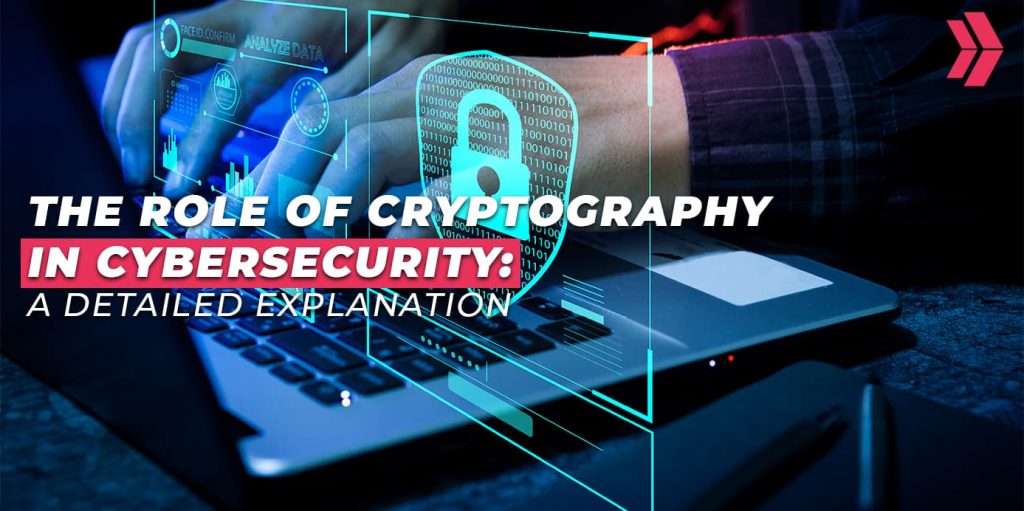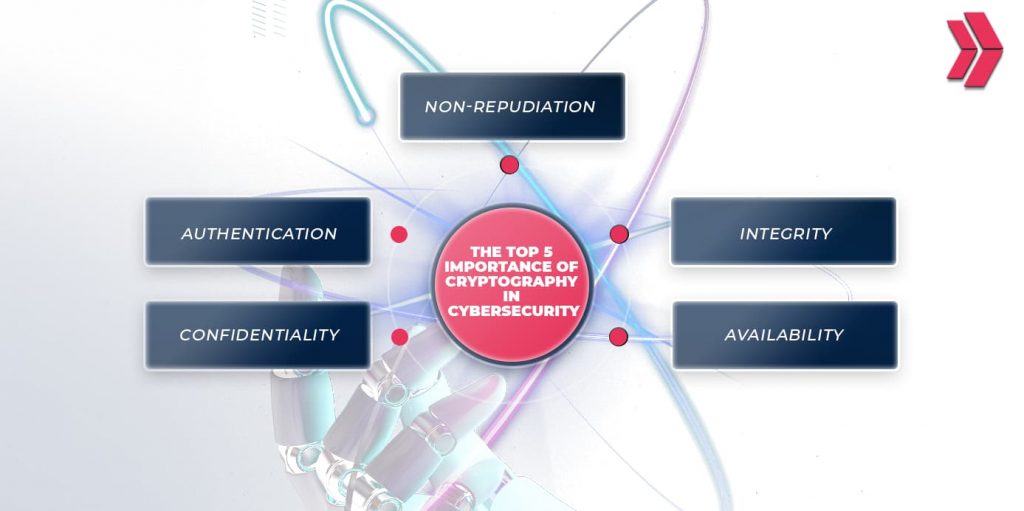Cryptography protects confidential information from unauthorized access, tampering, and exposure. Organizations are increasingly adopting encryption techniques, with 62% having a strategy in place, according to the 2022 Global Encryption Trends Study by Ponemon Institute. Learning cybersecurity cryptography appliances provides 5 crucial services:
- Authentication
- confidentiality
- Integrity
- Availability
- Non-repudiation
With the advent of quantum computing, the significance of cryptography in cybersecurity has become extremely crucial. Consequently, there is a high demand for cybersecurity experts, particularly those who can learn, understand, and prepare for emerging threats. Post-quantum cryptography cybersecurity solutions offer robust approaches to safeguard sensitive information from potential attacks by quantum computers.
Success in a cybersecurity career path depends on possessing the best cybersecurity certifications and hands-on experience. Professionals who leverage cutting-edge tools like cryptography will have rewarding cybersecurity jobs and shape the future of the field.

What is Cryptography in Cybersecurity?
Cryptography is an indispensable component of contemporary communication systems, safeguarding communication channels in cybersecurity through sophisticated ciphers and codes. It involves using complex mathematical algorithms and protocols to prevent unauthorized access. Cryptography aims to maintain confidentiality and integrity in transmission by leveraging encryption and decryption techniques.
What is Cryptography?
Cryptography is the practice and study of techniques that secure communication and information by converting it into codes that only the intended recipient can comprehend. This process involves transforming human-readable plain text into machine-readable ciphertext, using an algorithm or a series of mathematical operations to protect sensitive digital assets.
Why is Cryptography Important in Cybersecurity?
Cryptography is a fundamental tool to safeguard critical data and prevent security breaches. Here are the top 5 importance of cryptography in cybersecurity:
- Authentication
- Confidentiality
- Integrity
- Availability
- Non-repudiation

1. Authentication
Authentication ensures secure communication by verifying the identity of systems or individuals. It is also instrumental in preventing fraudulent activities, such as spoofing or impersonation attacks. Cryptography employs various security measures, such as digital signatures, passwords, and multi-factor authentication, to verify the identity of the recipients.
2. Confidentiality
Cryptography ensures confidentiality by restricting access to sensitive data only to authorized individuals. Instant messaging applications, which we use daily, are a great example of cryptography, as they encrypt users’ conversations to prevent hacking or interception.
3. Integrity
Data integrity ensures that data remains uncorrupted and unmodified. Hash functions provide a mechanism to verify that data has not been tampered with between its source and destination. By generating unique values, hash functions can determine if any alterations were made during transmission.
4. Availability
Cryptography is mainly concerned with preserving data confidentiality and integrity. Nonetheless, it indirectly ensures availability through several mechanisms, including implementing secure communication channels and robust access control mechanisms to prevent cyber attacks and support system accessibility.
5. Non-repudiation
Non-repudiation is a security measure that ensures accountability of everyone involved in a communication or digital transaction. It prevents individuals from denying specific actions, such as sending a message or conducting a transaction, using cryptographic techniques that record and prove these actions to be true.
What are the Types of Cryptography?
Numerous cryptographic techniques are employed to safeguard confidential information from unauthorized access. There are several categories of techniques for different uses and levels of security. Here are the 3 types of cryptography:
- Symmetric-key cryptography
- Asymmetric-key cryptography
- Hash functions

1. Symmetric-key Cryptography
Symmetric cryptography utilizes only one key for encrypting and decrypting data. There are 2 primary algorithm types in symmetric key cryptography: stream and block ciphers. Some examples of symmetric key cryptography include AES, Blowfish, DES, and Triple DES.
Symmetric encryption is a quick and effective method for handling vast amounts of data. However, one serious challenge is keeping information confidential in transit. To address this, it is best to share private keys using the Diffie-Hellman key agreement, which is secure and reliable for exchanging essential information.
2. Asymmetric-key Cryptography
Asymmetric cryptography involves 2 distinct keys – public and private keys. Only the private key can decrypt data when it is encrypted with the public key. The public key is disseminated freely, while the private key is kept confidential to address the challenge of distributing symmetric cryptography keys. Examples of asymmetric cryptography algorithms include ECC, DSA, and RSA.
Asymmetric encryption is a method that adds an extra layer of security to data during transmission and improves authentication measures. However, it has drawbacks, such as being comparatively slower and less flexible than symmetric encryption.
3. Hash Functions
A hash function is a type of encryption that does not require a key to operate. Hash functions are mathematical algorithms that take any data length and produce a fixed-length output. These mathematical operations generate a unique, irreversible value from the input data.
Any alteration in the input will change the hash value, which indicates a breach in data integrity. The hash functions produce deterministic results and can be utilized for various purposes, including digital signatures, integrity verification, and password storage. MD5, SHA1, SHA256, and SHA512 are popular hash algorithms.
What are the Applications of Cryptography in Cybersecurity?
Here are the top 5 applications of cryptography in cybersecurity:
- Authentication
- Data encryption
- Digital Certificates and Signatures
- Secure Communications
- Blockchain

Authentication
Cryptography is crucial in verifying the authenticity of users and systems. Authentication mechanisms, such as multi-factor or traditional passwords, rely on cryptography principles. Encryption protocols and algorithms ensure that only authenticated entities can access, minimizing unauthorized access and data tampering possibilities.
Data Encryption
Data encryption enables individuals and organizations to protect sensitive information. Encryption helps to keep data confidential and secure through various techniques such as full-disk encryption, end-to-end communication, and file and password storage. Maintaining security and preventing cyber intrusions against digital information stored on devices or cloud platforms is essential.
Digital Certificates and Signatures
Digital signatures are cryptographic tools that verify the integrity and authenticity of data. Users can use digital certificates to ensure their digital communications remain secure and trustworthy. A digital certificate is needed to create a digital signature, which utilizes public key infrastructure and cryptography to prove the authenticity of a user, device, or server.
Secure Communications
Cryptography ensures secure online communication by providing robust mechanisms to maintain the confidentiality and integrity of data transmitted over networks. Cryptographic algorithms and end-to-end encryption are employed in daily email traffic, messaging apps, and online transactions. TLS and SSL protocols make online communication secure.
Blockchain
A blockchain consists of blocks that contain datasets. Cryptographic algorithms ensure the integrity, security, and anonymity of the data. The algorithms provide each block with a digital signature, guaranteeing that the information cannot be tampered with or altered. Blockchain is a highly secure technology for storing and transferring data.
What is the Impact of Cryptography on Cybersecurity Professions?
Cryptography has a significant impact on shaping cybersecurity professionals’ responsibilities and job roles. Cryptography reduces attack vectors, establishes secure connections, and improves overall cybersecurity when implemented correctly. Cryptography creates security measures to protect information and communication from cyber threats using algorithms, ciphers, and other methods.
Can Cryptography Become the Cornerstone of a Cybersecurity Career?
Yes, cryptography can become the cornerstone of a cybersecurity career. Cryptography is an essential aspect, particularly when it comes to data protection. It provides a robust foundation for those seeking a rewarding and meaningful career in this industry. With the advent of quantum computing, cryptography will become even more critical. Quantum computing challenges current cryptographic methods, and post-quantum cryptography offers potential solutions to future challenges. The need for advanced techniques in the threat landscape emphasizes the significance of cryptography.
What is the Intersection of Cryptography and Cybersecurity Jobs?
The convergence of cryptography and cybersecurity jobs requires expertise in both fields. The intersection of cyber-related job opportunities necessitates a multidisciplinary approach. Examples of some roles include cybersecurity analysts, consultants, security software specialists, and cybersecurity engineers with cryptography knowledge.
What are the Essential Cybersecurity Certifications for Code-Cracking Success?
Proficiency in code-cracking requires specialized cybersecurity certifications widely recognized in the field. Obtaining such certifications would require an in-depth understanding of the technical aspects of code-cracking and its associated challenges. Some certifications necessary for successful code-cracking include CEHC, ISSP, CompTIA Security+, GSEC, and OSCP.
How to Create a Cyber Security Career Path to Prepare for a Secure Tomorrow?
A successful cybersecurity career combines education, certifications, and hands-on experience. Networking provides valuable opportunities to keep up with emerging trends and best practices. Continuous learning is essential to prepare for future security challenges. Professionals can prepare for a promising cybersecurity career path with passion and commitment to ensuring a secure tomorrow.
In conclusion, cryptography plays an integral role in cybersecurity by ensuring authentication, confidentiality, integrity, availability, and non-repudiation. Cryptography can be a cornerstone of a cybersecurity career, and specialists with a good understanding of cryptography and its applications are highly sought-after in the industry. Professionals with the best cybersecurity certifications and practical experience will succeed in their cybersecurity career paths and create a secure future.




